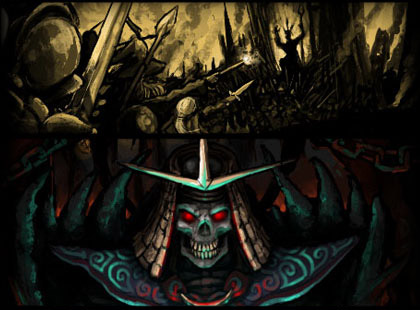One of the things I think that can really enhance a game’s experience is a quality soundtrack. As I mentioned in last week’s post my favorite game was Final Fantasy VI (US III). The genius behind this and other Final Fantasy games was Nobuo Uematsu. For those of you who don’t know Uematsu was the composer for the vast majority of the Final Fantasy series up until Final Fantasy XII where he worked on only a single song for that soundtrack, but is rumored to be working on the sound track for the upcoming MMO Final Fantasy XIV. Why so much attention to music or for that matter sound effects? Let me take you on a journey…
Dungeons of Dredmor: First Gameplay Trailer
We’re finally putting some video footage of Dungeons of Dredmor on the web for you to take a look at.
There isn’t much gameplay here – mainly we’re attacking monsters – so we’ll put up another trailer in the next couple of weeks or so with more magic and lutefisk action.
So Ridiculous That It’s Awesome
For Dungeons of Dredmor I’m currently revising the main title screen, credits, and high score background paintings, and I’ve effectively finished the introduction paintings in the last couple months. I even wrote the text for the intro; Truly, a renaissance man stands before you.

The Triumph of my Magic Steel
We’re getting into bunker mode here, and bunker mode means that we shut up and program. Programming soundtracks are infinitely variable, but everybody tends to have one. For Dredmor, 50% of the programming was done while drinking coffee and listening to Rhapsody albums. Rhapsody is a largely insane European power metal band who mainly sing about unicorns, swords of magic, and dwarven economic practices. Christopher Lee was on their last album. It’s a reasonably intense experience, and a certain amount of silliness from the albums has transfused itself into Dredmor like some kind of musical background radiation.
Everybody has crunch mode stories. One of my favourite ones in my experience was several years ago – back in 2001 – when I was trying to ship a first person shooter using The Goddamned Lithtech Engine. Lithtech Talon, back then, was not known for its robustness, and most of my job description involved taping bits of it back together in order to get things shipping on time. One last problem we had before shipping our demo was that certain objects were suffering from z-fighting with the wall. Depth buffer precision issues are notoriously hard to fix, so I decided that the easiest thing to do – given that this was a last minute fix – was to tag the offending models (which were lights, or something) and give them a little depth bias in order to stop them from fighting with the walls. With that done, and a few more bugs taken care of, I crashed on the company couch in case I was needed later.
Three hours later, I was woken up: QA had gotten the build of the demo, gone through it, and wanted to know why there were vases floating through walls. It turns out that the depth buffer bias had been cranked… a little too high at the last minute, and on some of the wrong things. It still took me fifteen minutes for my brain to figure out how that was even possible.
I hope to have something a little more insightful for you next week. Until then…
Doom week(s) and Bunkers.
It’s that time of year again, when students everywhere (well, everywhere on a semester schedule at least) undergo the long and grueling process of ingesting dangerous amounts of caffeine and overloading their short term memory capacity.
As one of these barely human coffee zombies, I am nearly free of the clutches of final examinations, but since Nicholas is also somewhat tied to the chains of academia, we’ve been forced to put development on hiatus until Monday.
Fear not, though! A bunker session the likes of which Gaslamp has never seen is slated for just the next day! I understand coffee and instant noodles are being stockpiled in the workplace of choice, and we are destined to either never emerge from our self-imposed programming exile, or we will shamble out of our dimly lit and stagnant bunker to bring to light something odd, fun, and addictive in video game form.

My Favorite Game
I figure since this is a gaming company I should take a week off to talk about my preference in video games starting with my favorite, Final Fantasy VI or as it was known at the time Final Fantasy III for the Super Nintendo.
Back in 1994 I was a young lad of 9 years who loved video games. It wasn’t that I just was lazy and didn’t want to go outside or anything along those lines; The simple fact of the matter is that I was really good at video games and got engrossed in the challenge. At the time we owned a Nintendo and I desperately had been wanting a Super Nintendo but my parents thought it was too expensive and why should I even bother wasting my money on another game system. Since it’s release I had tried everything to get my parents to buy me one but ended up settling for those special weekends where I earned the precious time with a rental SNES from the local Safeway for being good or whatever metric my parents were using to judge me at the time.
Creative Levity
Late one night, we set our scene:
David: Added dire asparagus and a crate of evil sprite. I’ll let you figure out what to do with them.
Nicholas: … “dire asparagus”?
David: I’m going with my gut on this one.
Nicholas: Probably wise.
Nicholas: I wonder what goes in the crate of evil.
Nicholas: I’ll do something for it.
David: Surprise me.
Nicholas: Will do. Maybe it releases evil.


Should I even try to justify this?
The Joys of Ruby
I really should be talking more about the programming decisions in Dredmor, but for the most part the programming decisions in Dredmor are uninteresting. There are a few little bits of cleverness lurking under the hood – there’s some good stuff in the map generation system, and some good stuff in the load/save system – but for the most part, Dredmor’s programming isn’t particularily sophisticated or challenging. Instead, I’d like to talk about some technology decisions that didn’t work out.
In the engine that we’re putting together for the next game that we’re making, and for the game that we tried to make before deciding to finish Dredmor, we found ourselves needing a scripting language. Scripting languages are important for games: they form a divide between certain elements of game logic and the engine itself. They also make it harder (if correctly implemented) for a game designer – who may not be thinking as a programmer – to crash the engine or to introduce Exciting Behaviours into C++ code. We wanted a scripting language, and I shopped around looking for one.
For our first attempt at solving this problem, we decided to use Ruby. Ruby is a scripting language that now powers… well, a fair amount of the web… due to its elegant design and a little library called Rails that you might have heard of. Ruby has a lot to like about it. It’s a smart, well-designed language that comes with a good set of useful primitives. It supports serialization and reflection of objects out of the box, it has a number of useful string manipulation functions, and it has utility libraries for everything under the sun. It looked like a winner, and it came with some binding code to help you integrate it into your C code. The problem, then, was how to integrate it into C++? How do we get two object-oriented programming models to play nicely?
Integration, surprisingly enough, turned out to be a very pleasant experience. I started with some good hints from Gaffer and his Ruby wrapping classes, and ended up mangling the hell out of his library to add some features specific to our needs (like cross-platformness and transparent object serialization.) The part that I found particularily delightful about the experience is that Ruby can internally serialize classes – including new, exciting sorts of objects – as plaintext strings. This made it very easy to get Ruby playing nicely over a network.
So, why doesn’t Ruby work? Short answer: the garbage collector sucks.
Long answer: Ruby’s GC does not support asynchronous garbage collecting, or incremental garbage collecting. Instead, when the garbage collector runs – it *runs*. And by runs, I mean chugs. I hope that some day this will get fixed, and would fix it myself except that I don’t know enough about Ruby’s internal source code or how to write a garbage collector to attack the job. If anybody out there knows something about these two topics and wants to make Ruby’s GC useful for games, let’s talk.
What are we going to do next? I’m not sure. My occasional hackmaster buddy, Ryan C. “Icculus” Gordon (that’s a mouthful), suggested Lua. Everybody does Lua these days, and that’s both a good thing and a bad thing. I suppose it does what you want it to do, but … I don’t know, something about it doesnt make me happy. AngelScript has also been floated, but I don’t know what the point is of embedding a language in a C++ application that programs exactly like C++. Next week, we’ll explore more interesting and arcane alternatives. Like that Erlang thing.
